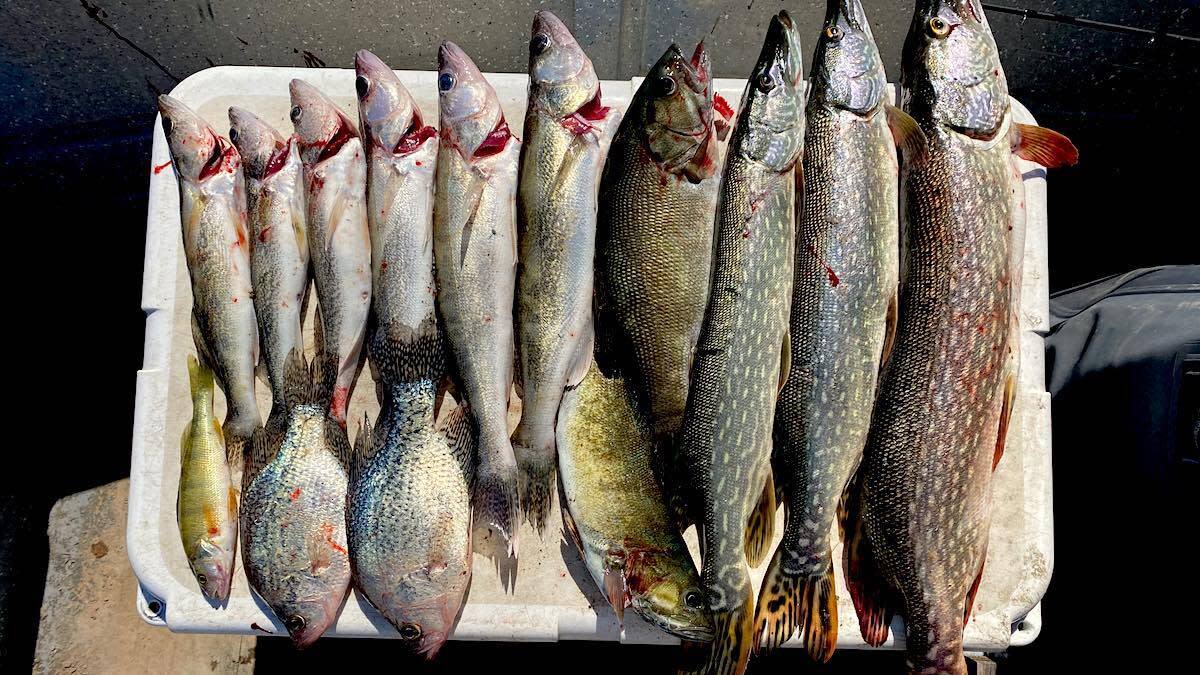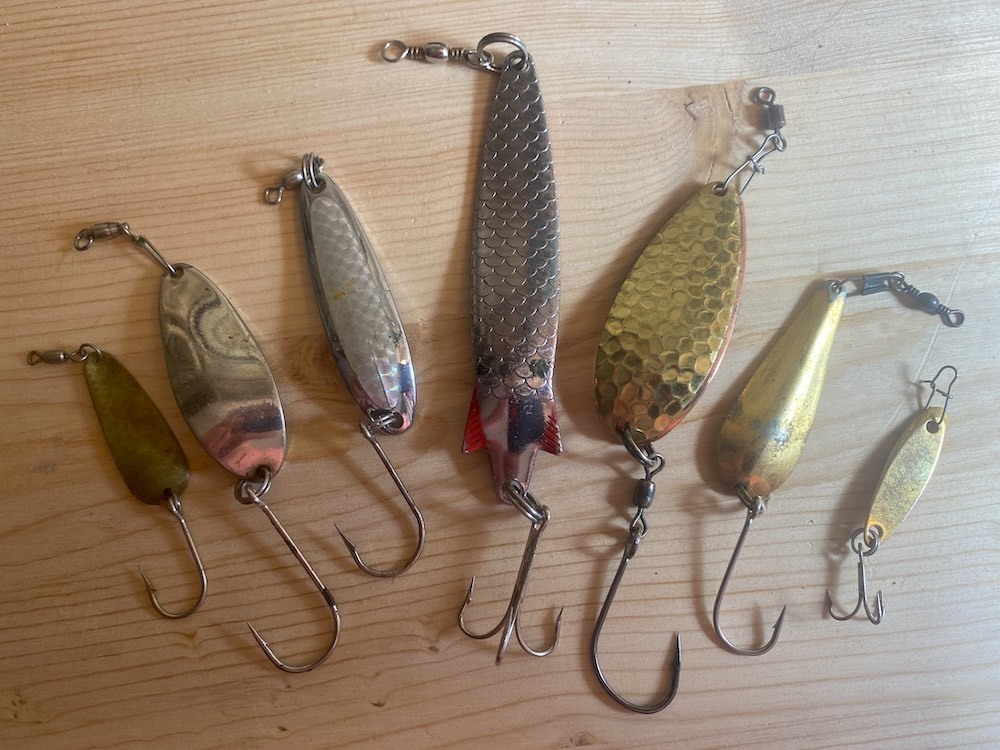
Simplicity is grace, so they say, and there’s nothing more simple than a single chunk of oblong metal with a hook attached to the back. I find grace in the subtle and nuanced motions you can produce with a simple metallic spoon.
You can slow-roll it deep or burn it shallow. You can jig it way down or skip it back across the surface if you have to. You can troll it or suspend it with bait under the ice. Best of all, you can swing it on a tight line across a river’s current. It never loses paint or thread or hair. There’s no plastic to break or tear. It never cracks or wears out.
As Joe Cermele notes in his sidebar about survival fishing gear in “The MeatEater Guide to Wilderness Skills and Survival,” the survival kits for Navy pilots in WWII included a bucktail jig with a handline. That wasn’t the best call, he says, because one swipe from a barracuda could rid you of all your wiggling bucktail.
“No matter where you are in the world, regardless of the water type you’re on, if it is populated by fish that eat smaller fish, they’ll eat a spoon,” Joe said. “Over time, that spoon may become scratched, nicked, chipped, and pitted, but rendering it completely useless is extremely difficult.”
You could conceivably use the same exact lure to catch a golden trout above 10,000 feet in the Rockies, a muskie in the backwaters surrounding the Great Lakes, a steelhead in coastal Alaska, and a giant adult tarpon in the Florida Keys. Take it anywhere in the world and you’ll be able to fish effectively for a massive portion of the fish you encounter. Our quarry sense their surroundings through their lateral lines, and spoons speak the language of vibration as well as anything.
Humans have been catching fish using this basic design since the Iron Age. Anthropologists have dated spoons discovered in Scandinavia back to the 8th century AD. The Dardevle Spoon, developed by Lou Eppinger in 1906, has appeared atop the rankings of greatest lures in fishing publications for a century. It’s probably fair to say that more fish have fallen to the spoon than any other lure.
You can buy spoons in every color combination imaginable, from the classic Daredevle red-and-white to space-age, prismatic, photorealistic fish patterns printed on the side. I even like jet black in very high, dirty water. There may be a time and a place for any and all of them, but for my money it’s impossible to beat real, polished metal coating or construction. Copper, bronze, silver, and gold dominate my tackle boxes and even my survival kit. There’s no fancy paintjob to chip, metal throws the most light reflection, and you’re able to evoke the broadest range of bait species.

Understanding Spoon Types Lure makers have designed spoons in pretty much every conceivable shape, thickness, and weight. While some are rather generalist, others serve highly specific purposes.
The wider the spoon and deeper the concave cup, the more wobble it will produce. These “tear-drop” shaped spoons create the most vibration, but that in turn creates drag, thus lifting the lure toward the surface with a fast retrieve or against heavy current.
Flatter and longer or more needle-shaped spoons create a tighter, narrower wobble, but that also makes them more hydrodynamic. A thin, narrow spoon can be retrieved and trolled faster or held against stronger current without rising out of the zone than a wider model.
Those are the extremities of the spectrum. Spoon design usually adopts several elements to produce a desired effect. Many spoons can be used for multiple purposes, but these are the broad categories of intent.
Casting Spoons are heavy and aerodynamic for flight to faraway places. The most extreme example of this might be the famous Acme Kastmaster. Hardly a spoon at all, this thick, geometric, hunk of metal packs a lot of weight into a small package that will sail for miles across the lake if you let it. An angler recently broke the Montana brown trout record with a Kastmaster. Lots of the more generic spoon styles would also fall into the category of cast-and-retrieve too, including the Daredevle, the ever-deadly Krocodile, and my personal favorite do-it-all model, the Little Cleo.
Trolling Spoons are generally light and thin, often made of sheet metal. The intent is often to troll these rigs behind an inline weight or downrigger ball so the metal flutters freely and won’t sink too fast toward the bottom and potential snags. I grew up catching salmon on the Luhr-Jensen Coyote Spoon, as well as the diminutive Dick Nite. Most spoons can be trolled, but thin, flat ones will often perform best.
Jigging Spoons or “slab spoons” are thick and heavy, often lacking a curve or cup. The intent is to sink quickly to the bottom to bounce vertically with a fluttering fall. I recently watched my friend, tournament angler, and videographer Matty Wong of CaptureFish pull a rabbit out of a hat with a Hopkins NO=EQL on a very cold winter day in Southern California, producing the only fish of the trip—a largemouth sitting in nearly 40 feet of water. I’ve personally taken species as diverse as crappie, kokanee, and halibut on jigging spoons.
Swinging Spoons are a sub-category of casting spoons designed specifically for working across a river’s current on a tight line, usually for salmon, steelhead, and trout—but I’ve also used this method to great effect on riverine smallmouth bass. These spoons are usually rather heavy with a moderate curve and an extended tear-drop shape to provide a lot of vibration without too much drag. One of my greatest joys in life is working down a winter steelhead stream with a spoon, casting to the far bank, swinging down and across, covering the whole river and picking apart likely holes and structure, much like I would with a Spey rod. That grab is among the most electric there is. My favorite swing spoon comes from RVRFSHR but the B.C. Steel is a close second.
Weedless Spoons might be a thing of the past, but I still have a few stashed away that are much older than I am. These long, wide lures have an integrated hook rather than one pivoting freely behind, usually with a flexible weed guard allowing an angler to skip the spoon over lily pads and mats of vegetation. The Johnson Silver Minnow is the classic weedless spoon.
Spooning Tackle and Tactics You should never, ever fish a spoon without a good swivel in front of it. That’s just a novice move and will cause frustration later when all your line spins up into tight pigtails and, eventually, knots. A spoon is meant to spin, so you need to facilitate that action.
I also add a swivel between the body and the hook on spoons I’m using for steelhead, Chinook, and other large fish so they can’t twist against the lure and pull the point out. To the same end, I prefer single siwash hooks over trebles because they don’t provide the fish with counter-twisting leverage.
In warmer water, a steady retrieve may be most productive, but it’s always worth trying an erratic, jerky presentation if the former fails. When the water is cold, lethargic fish may be more likely to seize a fluttering, dropping spoon, or one slow-rolled down deep, not fast enough to even turn over. You can even hop a spoon along the bottom as you would a jig—a lethal tactic for flounder and other bottom-dwelling fishes. Because there is no bobber or inline weight, spoons cast accurately and can get into tight places other rigs wouldn’t dare venture.
One of the most brilliant fishing feats I ever witnessed was performed by a man on a small, popular steelhead stream flowing into Washington’s Puget Sound. Right below the bridge where people accessed the river was a strainer, a big alder tree fallen in the river. Dozens of anglers walked right by it every day, unable and unwilling to get their bobber rigs or drift gear up under the branches. While I was fishing the hole below, I watched a guy wade out to the middle of the river and plant himself upstream of the tree. He cast downstream and back toward the bank, then on a tightline swung the spoon up under the tree until it held, fluttering, straight below him. Then he let line off his baitcast reel incrementally, backing the lure down under the cover. Then his rod jerked and a chrome-bright hen steelhead came cartwheeling out of the branches. I could only imagine his satisfaction in catching a fish that numerous veteran anglers walked right past. A spoon is practically the only rig that could be employed so delicately and technically to aggravate such a fish that was clearly hiding from fishing pressure.
Simplicity is grace, and spoons are both simple and graceful. They cast beautifully and fish easily, while still providing endless room for nuance and skill. Something about that wobble and flash just magnetizes fish. The basic and durable design will keep producing as long as you live—so long as you don’t hang it in an unreachable tree branch.





